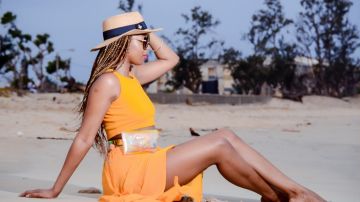7 Things You Need to Know Before Getting Braids This Summer
‘Tis the season to no longer stress out about your hair

Photo: Unsplash/@gracamateusassane
‘Tis the season to no longer stress out about your hair. After months of straightening, applying heat, and relying on every anti-frizz product under the sun. Summer is finally here and it’s the best time for women to sit back, let loose and begin wearing their hair wild, curly, and free — without apology.
For some hair types though, even the summer presents its challenges for curls and kinks. From humidity to … well, straight up sweat, rocking your natural mane can become cumbersome as well. That’s why so many women of color opt for a super cute alternative: braids.
While braids are trendy, fresh, and fly there are a few things every woman needs to know before committing to them. We’re breaking down all the things you must know before making the leap. wp_*posts
Do Some Serious Lock-Care Prior to the Salon
https://www.instagram.com/p/BkquCfkHr54/
Rocking plaits can feel like a major reprieve from daily tugging, brushing, and even washing your hair. But there is some pre-work you need to commit to before getting a head full of braids, and most salons expect you to show up with your hair clean and ready for braiding.
We spoke with Hannah Diop, founder of Sienna Naturals, a hair care line for textured hair, who downloaded us on everything one needs before they commit to a style.
“Before braiding you want to start with a very clean, clear and moisturized scalp; and strong, clean, moisturized hair. For all of the glamour and convenience of braids, we need to make sure we are setting our scalp up for success,” Diop explains.
“While hair is typically lower maintenance in this protective style, it’s important to remember moisture and proteins will still naturally dissipate from the hair over time, so maintaining a cleansing/moisturizing routine during your braided style is very important.”
Diop’s line features products with plant-based ingredients that smell delicious and offer serious conditioning. The night before braids, try applying Don’t Flake scalp treatment; it has Copaiba which provides natural anti-inflammatory and anti-bacterial benefits. Then lather up with Hapi Shampoo to give hair a rich moisturizing moment. Follow up with the Plant Power Vegan Protein Moisture Repair Mask. This will rebalance moisture-protein levels for strength and elasticity. We absolutely love that it has baobab and green tea proteins — the good stuff — to keep our locks strong while in braids. wp_*posts
Choose Your Salon Wisely
Horror story alert! To do a bit of research for this piece, I personally sought out a new hair braider — via Instagram. A simple hashtag search using the name of the braids you want and the city you live in (for example, I typed “#passiontwistsdc”) should open up a world of potential stylists in your city and examples of their work.
While typically this has worked out for me in the past, this time, I booked a braider who was not only unprofessional and unlicensed but who also left my hair in complete disarray.
While Instagram and Twitter are awesome tools for networking and checking out people’s work, be sure to do more research on the braider you’re considering going to. Ask about their years of experience, share with them details about your hair length and texture to ensure they’ve worked with hair like yours before, and look for their license when you arrive at the salon (most stylists will have it posted on the wall).
If all else fails, never hesitate to leave a salon if you are concerned or have a gut feeling things may go left. wp_*posts
Know That Not All Braids Are Created Equally
There are literally hundreds of braids styles out there to choose from — from traditional cornrows to Fulani braids to box braids and twists. They all come in various lengths, techniques, and sizes.
The Traveling Braider in Washington, D.C. is known for her popularized “knotless” braids technique for box braids, which can put less tension on your roots over traditional box braids. Her website also hosts tons of other examples of various braid styles to consider.
At the end of the day, you can have fun with it, but it’s important to know what styles pair well with your hair texture, length, and thickness because not all braids work for everyone’s hair. wp_*posts
Understand Your Texture and What It Can Handle
Reality check: braids are not for everyone. While it may seem as though all the girls are rocking them these days, the truth is many are wearing braided wigs to prevent sacrificing their own tresses to natural hair processes.
Traditionally, braids have been worn by Black women as a protective style for their hair, but they have also been known to be a style that some women avoid due to their fine or soft textures. While women with naturally thick hair may find braids to be a relief and even a hair growth solution, those with fine or thin hair can find it to be a true danger.
“The added weight of each braid on a small circumference of scalp puts additional tension on the follicle (responsible for anchoring our hair to the scalp),” Hannah Diop told us. “This can cause inflammation, irritation and at worst — permanent hair loss if you don’t take care.”
Talk to your stylist about which braid style is right for your hair length and thickness and ensure that you’re getting a style that won’t sacrifice your edges or length later. wp_*posts
Be Careful Not to Use Appropriation Language Once You Have Braids
https://www.instagram.com/p/BwQ9QdgFIE_/
Braids have rich history and tradition in African countries, and in the Western Hemisphere have been long used for everything from hair management to mapping (truly, braid patterns were created to be used as a map to freedom for some slaves).
The irony, then, is not lost on some as braids have become a mega beauty trend. White women from Bo Derek to Kim and Khloe Kardashian have been rocking many braided styles after seeing them in the culturally significant beauty looks of non-white women.
At this stage in the beauty world, it is not uncommon to see a white woman wearing the same style of cornrows that black and brown women have worn for years, and while there is nothing inherently wrong with that, it can be tricky when women attach colonizing terms to their hair.
For example, “boxer braids” is a new term created to describe a two-braid style that mimics French braids. The term became popularized once the Kardashian-Jenner clan began wearing the style, but has long been worn by women of color and known as cornrows.
Once you get your new look and hop on Instagram to share, make sure you’re correctly tagging and talking about your style to give credit to the history of braids that have long existed before they became a trend. wp_*posts
Find The Right Resources If You Choose to DIY
https://www.instagram.com/p/BaM1aFglTBg/
If you dare to try installing your own braids, make sure you have the right tools at your disposal.
In Braid It, a braiding guidebook by Jessy Linton and Taiba Akhuetie, the authors suggest grabbing a pintail comb, a styling product for manipulation (Got2B All Star Styling Treatment is recommended for those with “European hair” textures), sectioning clips, and hairspray.
However, for those with more textured hair, hairspray likely won’t be necessary but a leave-in-conditioner and shine spray will be. Try the Dew Magic Leave-in Conditioner by Sienna Naturals and Shea Moisture’s Coconut & Hibiscus Hold & Shine Moisture Mist.wp_*posts
Have Fun With It
https://www.instagram.com/p/BkPpIFMlTHD/
Run, don’t walk, to YouTube to begin thinking about all the ways you’ll style your new braids. Braids are fantastic for up-dos, the ever-so-trendy top bun, or in a side swept look. Whether you choose to rock them short or long — or both — is your choice!
Just be sure to give yourself a few days after getting your hair braided to rock the braids down. Pulling them up into a trendy top knot too soon could result in tons of painful tension at your roots — or worse, they can pull out your hair.
Talk to your stylist about maintenance and care, and then hop on Instagram to show off your new look.

















